How do magnetostrictive sensors enable absolute position measurement?
At the heart of precision position sensing lies magnetostriction, a unique physical phenomenon where certain ferromagnetic materials change their shape or dimensions when subjected to a magnetic field. This fundamental principle enables magnetostrictive sensors to deliver exceptional accuracy in position measurement applications. The magnetostrictive effect was first discovered by James Joule in 1842, but it wasn't until recent decades that this principle has been successfully implemented in industrial sensing technology.
The fundamental working principle of magnetostrictive position sensors involves three key components: a waveguide wire made of magnetostrictive material, a position magnet that moves along the sensor length, and an interrogation pulse that travels through the waveguide. When an electrical current pulse is sent through the waveguide, it generates a circular magnetic field along the entire length of the wire. The position magnet creates a second magnetic field that interacts with the current-induced field at precisely its location point.
This magnetic interaction produces a mechanical torsion wave in the waveguide through the Villari effect, which travels at ultrasonic speed toward both ends of the sensor. Sophisticated electronic circuitry measures the time difference between the initiation of the current pulse and the arrival of the torsion wave, calculating the exact position of the magnet with remarkable precision. The entire process occurs within microseconds, enabling real-time position tracking.
One of the most significant advantages of magnetostrictive sensors is their ability to provide absolute position measurement without requiring homing or reference points upon power-up. Unlike incremental encoders that lose position information during power outages, magnetostrictive sensors maintain absolute position data, making them ideal for critical applications where position integrity is paramount. This feature eliminates the need for complex initialization routines and reduces system downtime.
The non-contact nature of magnetostrictive sensing technology ensures virtually infinite mechanical life and exceptional reliability. Since the position magnet doesn't physically contact the waveguide, there's no mechanical wear, friction, or maintenance requirements associated with the sensing element. This characteristic makes these sensors particularly valuable in harsh industrial environments where contaminants, vibrations, and extreme temperatures would compromise conventional contact-based sensors.
Modern magnetostrictive sensors achieve exceptional measurement resolution, typically reaching micron-level accuracy, with some high-end models capable of resolving positions within 1 micrometer. This incredible precision stems from advanced signal processing techniques and the constant speed of sound in the waveguide material, which remains stable across varying environmental conditions. The technology provides excellent repeatability, often exceeding 0.001% of full-scale reading.

Industrial applications of magnetostrictive position sensors span across numerous sectors including hydraulic cylinder position monitoring in heavy machinery, precision feedback in injection molding machines, and position control in automated manufacturing systems. They're particularly valued in applications requiring long stroke measurement with high accuracy, environmental resistance, and absolute position knowledge throughout the entire measurement range.
When compared to other position sensing technologies like LVDTs, potentiometers, or optical encoders, magnetostrictive sensors offer a unique combination of absolute positioning, high accuracy, robustness, and long-term reliability. While each technology has its specific advantages, magnetostrictive sensors consistently outperform alternatives in applications requiring non-contact absolute measurement over medium to long distances with exceptional environmental durability.
The implementation of magnetostrictive sensors continues to evolve with advancements in materials science, electronics, and signal processing algorithms. Modern sensors incorporate temperature compensation, self-diagnostics, and digital communication protocols like IO-Link, CANopen, and Ethernet/IP, making them increasingly intelligent and easier to integrate into sophisticated industrial automation systems. These developments ensure that magnetostrictive technology remains at the forefront of precision position sensing solutions.
 UpgradingYourLevelMeasurementS
UpgradingYourLevelMeasurementS
 Why are magnetostrictive level
Why are magnetostrictive level
 ComparingMagnetostrictiveandRa
ComparingMagnetostrictiveandRa
 MagnetostrictiveLevelSensorfor
MagnetostrictiveLevelSensorfor
